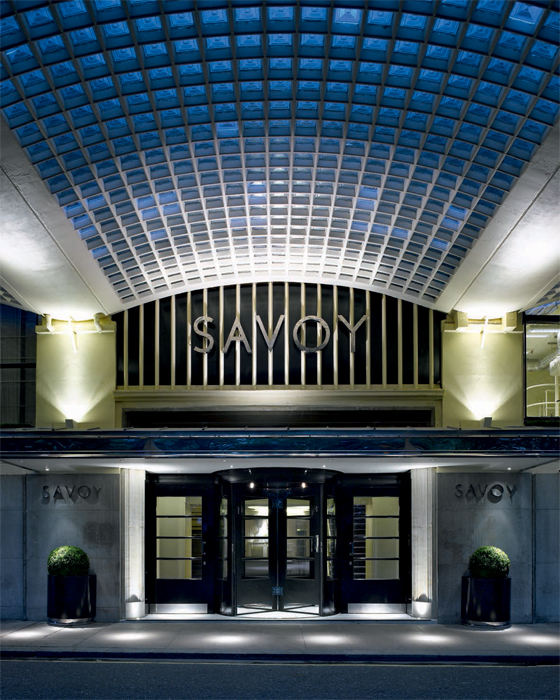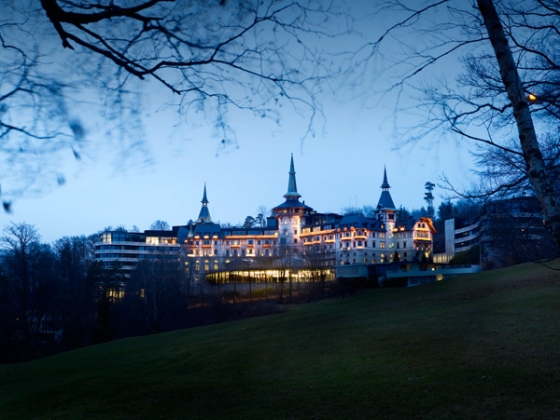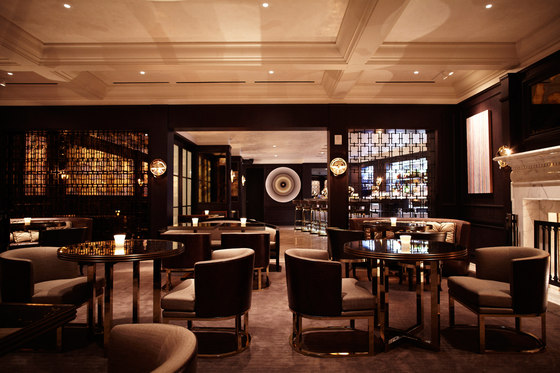The Grand Hotel: The Bourgeois Dream of an Aristocratic Castle
Scritto da Klaus Leuschel
Bern, Svizzera
25.04.13
Journalist Klaus Leuschel provides a crash course in, and a guided tour of, grand hotels, and how even design excellence in the five-star tradition is of no avail when the quality of hospitality does not match it.
Riverside entrance canopy, The Savoy, London; courtesy of The Savoy
That the rise of the grand hotel reached its apogee in the late 19th century was no coincidence: electricity, railways and ocean liners were to their day what personal computers, iPads and smartphones are to ours. The innovations of the age brought significant refinements (among them modern sanitation and lifts) and – as is their wont – also triggered major upheavals within society. Thus, we find such establishments frequented by the fin-de-siècle nouveaux riches, who, having made their fortunes from mining, rail transport or power generation, saw in the grand hotel’s pomp and splendour the fulfilment of their “Bourgeois Dream of an Aristocratic Castle” (“Der Bürgertraum vom Adelsschloss. Aristokratische Bauformen im 19. und 20. Jahrhundert”, W. Richter and J. Zänker, 1988). Architecturally, most grand hotels consequently resembled gigantic palaces – majestic presences that, at night, blazed with the light from countless windows. For a detailed description, see Nikolaus Pevsner’s “History of Building Types“(1976), still the authoritative work on the hotel as a genre.
The dramatic slowdown in the evolution of grand hotels in the first half of the 20th century is equally unsurprising, given the backdrop of two world wars sandwiching a great depression. That should not, however, detract from the few notable exceptions that did get built, be it Turmhotel Seeber (now Parkhotel) in the Tyrolean town of Hall (designed by architect Lois Weizenbacher), Bella Lui in the Valais resort of Crans-Montana (by Arnold Itten and Rudolf Steiger) or the Monte Verità in Ascona (by Emil Fahrenkamp). But, although the new age demanded a suitably technical architectural expression, such forms were much less to the taste of the clientele to which the grand hotel owed its success. This contradiction can be seen particularly clearly at the Savoy – “London’s most famous hotel” – where the traditional grandeur of Thomas Edward Collcutt’s original 1889 building and the later Strand block additions combine with later Art Deco embellishments. One such addition saw the statue-topped entrance canopy gain a gleaming stainless steel fascia, giving it a not entirely coincidental resemblance to the famous Rolls-Royce front grille (both signify that one has truly arrived). The approach to that entrance, incidentally, is the only road in the UK where vehicles can legally drive on the right.
Lobby / Bar Eden Roc, Miami Beach: Morris Lapidus, 1956, renovated 1997 by Spillis Candela & Partners; Photo © Eden Roc Renaissance
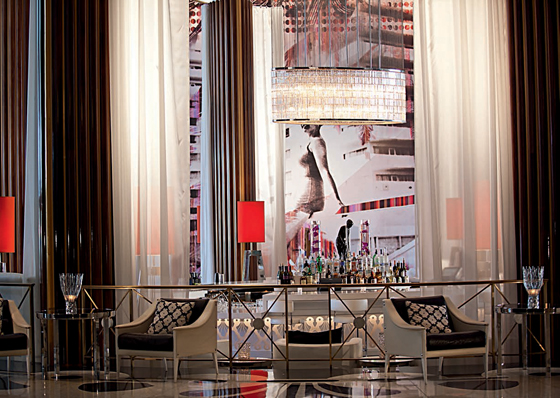
Lobby / Bar Eden Roc, Miami Beach: Morris Lapidus, 1956, renovated 1997 by Spillis Candela & Partners; Photo © Eden Roc Renaissance
×Lobby, Royalton Hotel, New York, 1898: redesigned by Philippe Starck, 1988, renovated 2007 by Roman & Williams; photo Nikolas Koenig, courtesy of Morgans Hotel Group
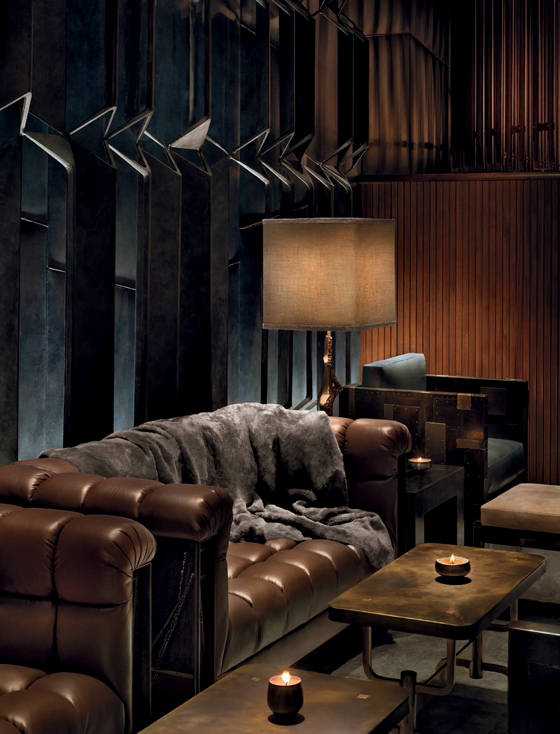
Lobby, Royalton Hotel, New York, 1898: redesigned by Philippe Starck, 1988, renovated 2007 by Roman & Williams; photo Nikolas Koenig, courtesy of Morgans Hotel Group
×The Lobby
Looking back over the modern age, anyone trying to find further developments in hotel architecture would have to scour their street maps for the few rare gems. And those that do represent important evolutionary milestones are all responses to the stacked rabbit hutches of a certain Conrad Hilton. His notion that a guest should be able to find their bed, wardrobe and toilet seat in exactly the same place, whether they are in Istanbul or in Frankfurt, has since attracted many imitators (Holiday Inn, Intercontinental, IBIS, Etap et al.) who have, between them, proved there is nothing that can’t be done a little cheaper.
In Miami Beach, Morris Lapidus took a rather different approach, helping to shape the image and public profile of the resort with his Fontainebleau hotel (1954) and the adjacent Eden Roc (1956) – the hotels that first put Miami Beach on the map as a destination for the rich and the beautiful. Nonetheless, Lapidus’ hotels were initially unable to shake the label “neo-baroque modernism” or, even more disrespectful, “gaudy kitsch”. Charles Jencks, though, saluted them, not unjustifiably, as forerunners of post-modernist architecture – after all, Lapidus was the first hotel builder to turn the lobby into a contemporary catwalk of vanities. In contrast, the more traditional European grand hotels, in line with the tastes of their exclusive clientele, viewed an intimate lobby as the only appropriate entrance hall. The prototype for the latter kind of lobby was created by César Ritz, the unofficial “king of hoteliers”, at the Carlton Hotel in London. When, a few days before the grand opening, it struck him that the lobby might make his special guest, the Prince of Wales, feel a little short, he added an extra step and hastily covered the resulting raised floor – with a red carpet (a flourish later echoed by Philippe Starck’s blue carpet in the lobby of the Royalton in New York). Throughout his life, Ritz railed against the “station hall atmosphere” that came to dominate American hotels and that, years later, culminated in the often cathedral-sized atria of John Portman, in which guests float down to the lobby in glass-pod lifts from 40 or 50 floors up like stars or starlets in a Hollywood movie. Here, the first impression is of pomp, but it is swiftly followed by the opposite of grandeur: hundreds of rabbit hutches cheekily marketed as “rooms”.
Dolder Grand Hotel, Zurich, Switzerland: extension completed 2008 by Foster + Partners; photos Foster + Partners
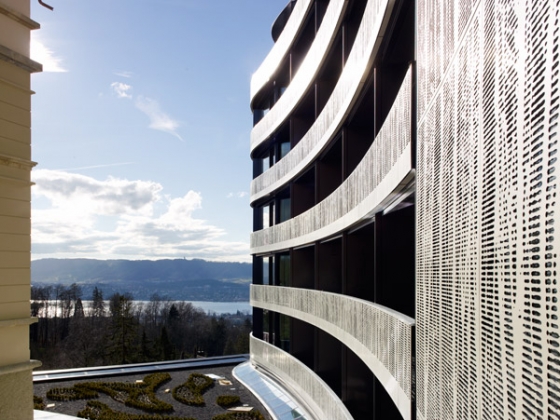
Dolder Grand Hotel, Zurich, Switzerland: extension completed 2008 by Foster + Partners; photos Foster + Partners
×Reception
On the subject of Hollywood: how many famous films feature a hotel reception and a commonly used counter with pigeonholes, revealing whether the occupants are in, if they have messages or post to collect? Well, those days are gone. Keys have long since given way to cards, faxes and telegrams to computer screens and email.
Rooms
One of the most carefully thought-out interiors for any hotel was surely that created by Arne Jacobsen for the SAS Royal (now Radisson Blue) in Copenhagen. The architect puzzled over plans until he came up with four different versions of the same room, from the traditional double to twin-bed, head-to-head and single-bed variants. This flexible interior concept was later picked up by the German firm Interlübke, which, together with designer Rolf Heide, created a hotel room that could be tailored to the guest’s individual needs within minutes; the transformation required no great physical effort and could even be done by the chambermaid.
Jacobsen crowned his contribution to hotel architecture with a materiality and colour scheme that made the ingredients of the interiors appear to be “made of one piece” that they came close to one of Harald Szeemann’s Gesamtkunstwerk (total works of art), so of a piece were their ingredients. Although the hotel has since been refurbished, one room still retains Jacobsen’s original furnishings, and its hallowed status can be gauged by the fact that it is the only hotel room after which a book has been named (“Room 606”, Phaidon Press, 2003). Only New York’s Morgans and Cologne’s Hotel im Wasserturm ( both by Andrée Putman), or Berlin’s Grand Hyatt, (Hannes Wettstein) can boast interiors that are similarly thoughtful in design. Morgans because Putman made optimum use of the expensive New York floor space without creating rooms that feel confined; the Grand Hyatt because Wettstein broke with convention and opened the en suite up to the hotel room, making the guest’s ablutions feel more like a private spa experience.
Hotel Bel Air, Los Angeles, USA: restoration completed 2011 by rockwellgroup; photos © Hotel Bel Air (top) and © Jimmy Cohrssen (above)

Hotel Bel Air, Los Angeles, USA: restoration completed 2011 by rockwellgroup; photos © Hotel Bel Air (top) and © Jimmy Cohrssen (above)
×Art
To calculate the art budget for each category, hotel operators use a sophisticated system that involves multiplying rooms and suites by an average amount. In most cases, the quality of the results should, by rights, entitle guests to compensation. Exceptions, as ever, prove the rule: at Morgans, Andrée Putman had nothing but an edition of Robert Mapplethorpe’s “Flowers” hung on the walls. At the Grand Hyatt Berlin, Hannes Wettstein took a different route, defining artworks as “disruptive influences” but also using them as a means of “rooting” the hotel experience, decorating standard-category rooms, for instance, with reissued photographs from the city’s Bauhaus-Archiv museum.
Summary
There are, of course, plenty more case studies we could look at; in the field of corporate design, for example, where the Dolder Grand in Zurich (Erik Spiekermann, United Designers) or the decade-long restoration of the Great Eastern Hotel in London (Conran & Partners) prove that intelligent design knows no bounds – even extending to logos, shower gels, soaps and bathrobes – and that there is still room for new modern classics.
Hotel Puerta America, Madrid, Spain, completed 2005 by Marc Newson Ltd; photos Rafael Vargas
The fact remains, however, that for those wishing to prosper on the hotel market, design excellence is of only superficial relevance. The quality of hospitality is the real key to success, as César Ritz well knew. In the aforementioned Carlton Hotel, the hotel side had an operating profit of 48%, while the restaurant’s margin was as high as 52%. Admittedly, Ritz had Auguste Escoffier in charge of his kitchen; all the same, it is a figure today’s hoteliers can only dream of, however many stars their hotels and / or restaurants may earn. The design of in-house restaurants, incidentally, is not something we’ve covered here as, nowadays, such establishments should really be treated as separate entities. Nor have we included unbuilt projects, even those that in some way tread new ground – the most impressive recent example being Herzog & de Meuron’s planned apartment tower for the mountainside above Davos, devised as a means of financing the renovation of the adjacent hotel. Unfortunately, the idea of skyscrapers on the Heidi-land slopes of the Swiss Alps has proved less than popular, despite its intelligent use of land resources.
As all clever marketing experts know, a successful hotel is like a bouquet of flowers: all the constituent parts have to be right for the bouquet not to seem a little tired or wilted. Even the smallest details can thus make all the difference, be it the pattern of the flooring (such as the bow-tie-motif marble in the Fontainebleau lobby), the canopy above the entrance, or even the design of the fruit bowls. As long as hotel management courses persist in teaching students to put three apples in a round vessel and four in a square one, however, we are unlikely to see anything as interesting as Alvar Aalto bowls in grand hotel rooms – which is a shame, given their intrinsically generous shape. Besides, is it so unreasonable for a guest to expect the fruit bowl to be refilled?
....
This article first appeared in form, issue no. 246
